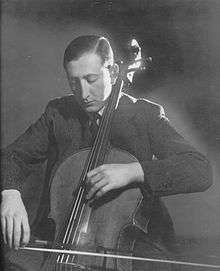Paul Hermann (composer)

Paul Hermann[1][2] or Pál Hermann (Budapest, March 27th 1902 - unknown 1944).[3] was a cellist and composer.
Career
Paul Hermann was born in Budapest, Hungary, on 27 March 1902 and came from a Jewish family. About his early childhood not much more than an anecdote remains: he was only prepared to study for his piano lessons if for every étude he prepared, he would receive one cent. He studied at the Franz Liszt Academy of Music from 1915–1919 and developed close relationships, both musical and personal, with his teachers of composition Béla Bartók and Zoltán Kodály, violinist Zoltán Székely,[4] and pianists Géza Frid and Lili Kraus.
At the Franz Liszt Academy of Music he studied cello under Adolf Schiffer and composition, first under Leo Weiner, who was also his teacher of chamber music. Already during his studies, Hermann was a frequent performer within and outside of the Liszt Academy. He started his international cello career at the age of 16, playing as a soloist music venues in Europe. Hermann felt that there was no need to finish his studies at the Liszt Academy.
Hermann taught cello and composition in the Musikschule Paul Hindemith Neukölln from 1929 to 1934. However, as the political climate in Berlin changed, most notably for Jews, and became more threatening, he decided to move first of all to Brussels from 1934–1937, and later to Paris from 1937 to 1939, and then on to the south of France. He was deported under the Vichy France régime in February 1944 from Toulouse to the internment camp of Drancy, and on 15 May 1944 he was sent to the Baltic States on the Drancy Convoy 73, and was not heard of again.
Performer and composer
He often performed recitals, or as a chamber musician with the Hungarian Quartet, with violinist Zoltán Székely and others. Of his concerts and recordings only the programs remain.
The Prins Bernhard Cultuurfonds set up the Paul Hermann Fonds in Hermann's memory which offers scholarships to promising young cellists from the Franz Liszt Academy of Music.
Compositions
Hermann left a small number of compositions, which are all now public domain.
- Grand Duo, pour violon et violoncelle (1929–30)
- Duo pour violon et violoncelle (1920, dédié a Zoltán Székely)
- Trio à cordes (1921)
- Toccata, pour piano (1936)
- Quatre Épigrammes, pour piano (1934)
- Trois mélodies sur des textes d'Arthur Rimbaud et de Paul Valéry, extrait de Charmes (1934–39)
- Ophélie
- La Ceinture
- La Dormeuse
Personal life
During the early years of his career, Hermann used to visit London for recitals and concerts and then would stay at the de Graaff-Bachiene family residence, owned by patrons of the arts. A story about one of these stays survives. Hermann and his friend Szoltan Zekely had entertained a large company of people in the De Graaff household in London in 1928 - at the peak of their musical partnership - with a house recital. Later that evening, Pál had been the centre of attention during the after-concert soirée that followed and had jokingly started to dance with his own cello in his arms. The people applauded and he continued to spin and dance until he fell and his cello broke to pieces. To bring the evening to a happy ending was their host Jaap de Graaff, patron and protector of the arts, who decided to buy a Gagliano cello for Herman, and a Stradivarius violin for Zekely.[5]
On a visit to Holland around 1929, Jaap de Graaff suggested for his niece Ada Weevers, who lived in Amersfoort, to go and see Hermann perform in Amsterdam, and when they met, Ada and Hermann fell in love, despite their different cultures, nationalities and religions. The young couple moved to Berlin in 1930, and they had a daughter Corrie Hermann in 1932.
Ada died after a drowning accident in the North Sea. As the political climate in Berlin for Jews became more and more threatening, he decided to hide his daughter with his non-Jewish sister-in-law in The Netherlands. Hermann moved on to work in Brussels from 1934–1937, and in Paris in 1937-1939, under a false name, and then moved to the south of France where he was hidden in a farmhouse near Toulouse of the French branch of the Weevers family, where he composed three melodies for voice and piano (Ophélie, La Centure, Dormeuse) and a violin/cello sonata. The composition of Ophélie, based on the character of Prince Hamlet’s beloved Ophelia who drowns in a river, may have been inspired by the tragic drowning of Hermann’s wife. He found the solitude of his hidden life on the farm hard to cope with, having lost his wife and far away from his daughter, and used to go out to Toulouse from time to time to teach and socialize, accepting the risk of being discovered.
Death
On one such visit, he was indeed picked up during a street razzia and transported to the Drancy concentration camp in spring 1944, and then onward to the Baltic States on the Drancy Convoy 73 on 15 May 1944, after which further traces of Hermann are missing.
Footnotes
- ↑ Trouw
- ↑ leosmit.org
- ↑ convoi73.org
- ↑ "Duo for Violin and Cello"
- ↑
References
- Paul Hermann (1902-1944)
- Nous Sommes 900 Francais, Eve Line Blum-Cherchevsky, Besancon, ISBN 978-2951370302, tome 7, pp 362-364
- Székely and Bartók: the story of a friendship
- Musique dans les Camps de Concentration
- "Pal Hermann attended those ISCM concerts..."